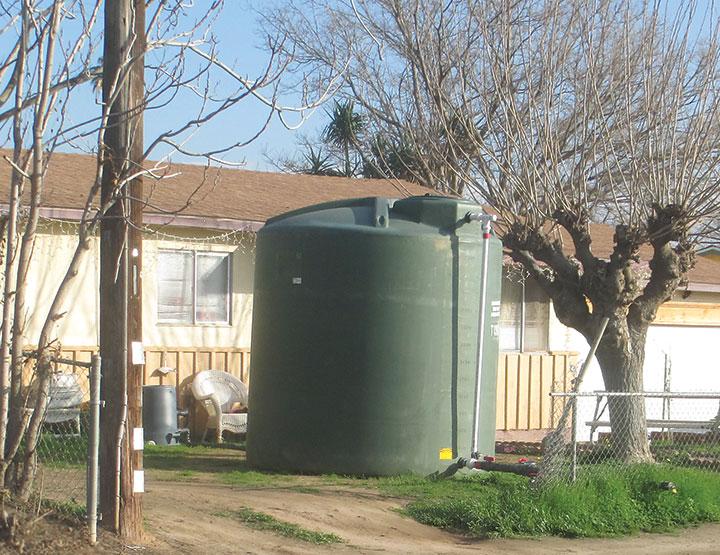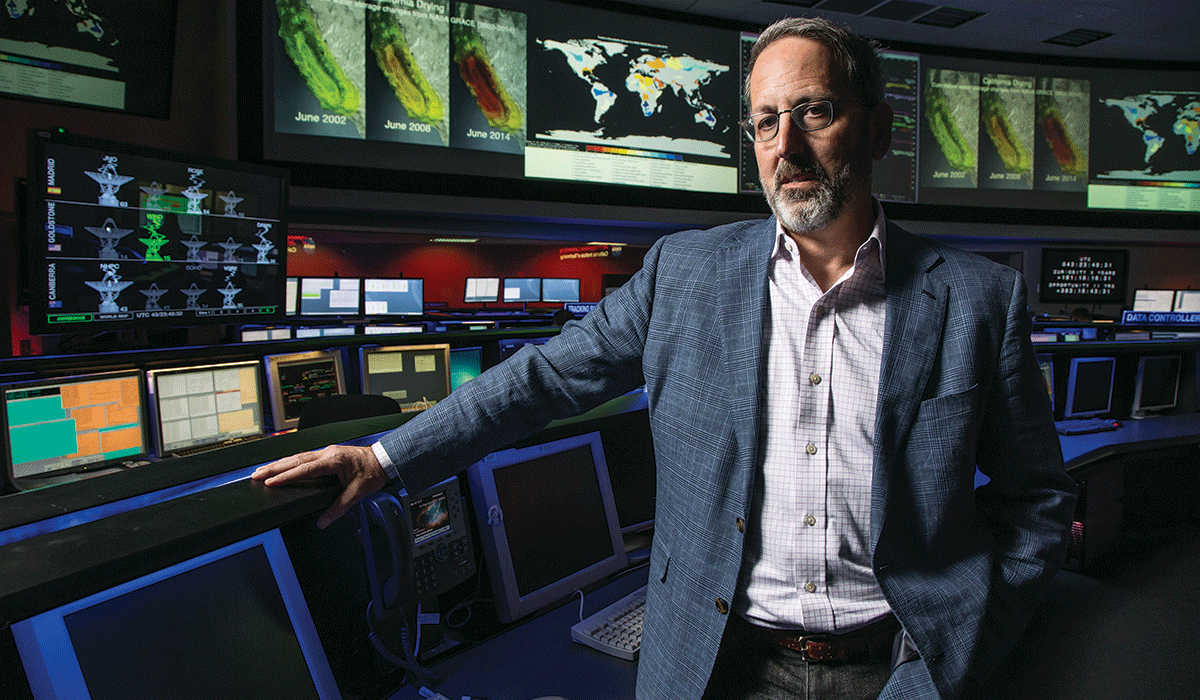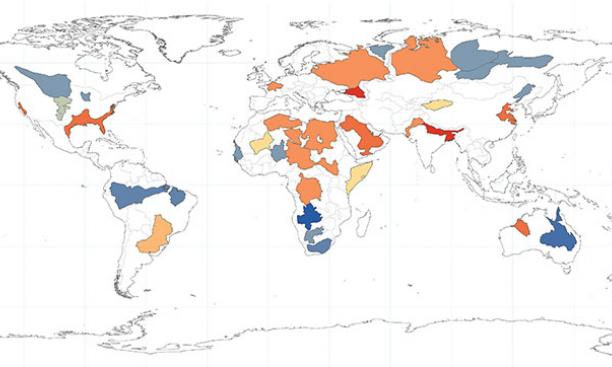“The Spring is beautiful in California. Valleys in which the fruit blossoms are fragrant pink and white waters in a shallow sea. ... The full green hills are round and soft as breasts. And on the level vegetable lands are the mile-long rows of pale green lettuce and the spindly little cauliflowers, the grey-green unearthly artichoke plants.”
John Steinbeck
The Grapes of Wrath
Like thousands of real-life Oklahomans during the Great Depression, the Joad family of Steinbeck’s novel fled dust and drought for a place that looked like paradise.
California still looks like one, even in the depths of winter. The state’s table-flat Central Valley produces almost all the country’s broccoli, spinach, artichokes, garlic, grapes, and canning tomatoes — nearly a quarter of America’s table food in all, and more than four-fifths of the world’s almonds. Drive along any back road, and orange groves or nut orchards stretch as far as the eye can see, the only sound the chugging of irrigation pumps.
In some places, though, there are disturbing sights the Joads might have found familiar. North of Bakersfield, acres of mature almond trees lie bulldozed in perfect rows, their roots ripped out of the ground and bleaching in the sun. Across from one of these fields outside the town of Delano, a man tends a farm stand offering local produce. Asked what happened to the trees, he doesn’t even turn his head.
“Drought,” he replies.
That drought, in its fifth year, eased somewhat over the winter, but the state still relies heavily on groundwater to feed its crops. The state now taps its aquifers for about 60 percent of its water, far more than in a normal year, when it could draw more from sources like rivers and reservoirs. In parts of the Central Valley, the ground is sinking — by more than a foot a year in some places — as the empty aquifer beneath it collapses.
The view is also troubling from space, which is the perspective Jay Famiglietti *92 prefers. Famiglietti is among the most vocal and influential scientists speaking out about drought and water conservation — a mild-mannered Jeremiah, or the “Al Gore of water,” as television host Bill Maher described him on his show. Last March, soon after Famiglietti wrote an attention-getting opinion column in the Los Angeles Times that predicted California had only 12 to 18 months’ worth of water left in above-ground storage, Gov. Jerry Brown imposed the state’s first-ever mandatory water restrictions.
A hydrologist at the University of California-Irvine and senior water scientist at the Jet Propulsion Lab in Pasadena, Famiglietti is using NASA’s Gravity Recovery and Climate Experiment (GRACE) satellites to study the world’s underground water reserves. His findings, and those of other GRACE scientists, are alarming, and they are not confined to California.
“Without intervention, I see a future in which we will be very challenged to produce the food that we need for this growing population, across the nation and all around the world.”
Jay Famiglietti *92
Data collected from GRACE over more than a decade, and published last July in a study Famiglietti co-authored in the journal Water Resources Research, showed that 21 of the world’s 37 largest aquifers — which collectively provide water for more than 2 billion people — have passed “sustainability tipping points.” It is no coincidence, he says, that countries sitting atop four of the world’s most stressed aquifers — Turkey, Syria, and Iraq (the Arabian aquifer); India and Pakistan (the Indus Basin and Ganges-Brahmaputra Basin); and Libya and Niger (the Murzuk-Djado Basin) — all have had political unrest driven in part by food shortages caused by a lack of water.
Famiglietti has been spreading his warning on media outlets including 60 Minutes and the 2011 documentary film Last Call at the Oasis, as well as writing scientific papers and op-eds for mass consumption. “We’re not just up a creek without a paddle in California,” he wrote in the Los Angeles Times piece, “we’re losing the creek, too.”
Broadly speaking, California gets its water from three places. First, from its own rivers, reservoirs, and snowmelt, but that water has been hard to come by as the drought, estimated to be the worst to hit the state in 1,200 years, stretches on. Second, piped in from out of state, chiefly the Colorado River, but the drought has limited that supply, too. Third, as a last resort, from groundwater in the aquifers.
Famiglietti uses the analogy of money to describe how we use water: Surface water, he says, is like cash. Aquifers, on the other hand, are like your retirement savings, a reserve set aside for a not-so-rainy day. It’s OK to dip into savings in case of emergency, but if you rely on it to pay your monthly bills, you are courting trouble. That, though, is what many agricultural regions around the world are doing. Drought makes over-pumping worse, but the pumping continues even in wet years because demand for water exceeds the surface supply.
California’s vast Central Valley aquifer (actually three smaller aquifers) encompasses approximately 22,000 square miles and runs roughly from Bakersfield to Mount Shasta, about 60 miles south of the Oregon border. As writer and Princeton professor John McPhee ’53 explained in his 1993 book Assembling California, the Central Valley once was the bottom of the ocean; the aquifer formed during the Pleistocene Epoch, when the climate was much wetter and the area had a Mississippi Delta-like flood plain depositing a deep layer of freshwater-logged sand and gravel. “A whole lot went into the savings account then,” McPhee says. Now, it’s diminishing, and at a quickening rate.
California’s unslakable thirst can’t be blamed on golf courses and swimming pools, though they don’t help. Agriculture drives the demand, using 80 percent of the state’s water. It takes a gallon of water to grow a single almond, for example, and nearly 700 to grow the alfalfa needed for a cow to produce one gallon of milk.
Vegetable fields can lie fallow during a drought, but fruit and nut trees must be watered or they will die. When shallow wells tap out, farmers drill deeper in search of even more ancient sources. Water being sprayed on trees today probably fell on California 20,000 years ago. Many trees that can’t be watered are bulldozed.
Meanwhile, higher temperatures mean less precipitation in the middle latitudes, which means even more reliance on groundwater. And the aquifers are slow to refill: After it is used, much of the water evaporates or makes its way into streams and eventually out to the ocean, further raising sea levels. The empty aquifers cannot support the weight above them and may collapse, compressing air pockets in the soil and making them harder to refill.
“It’s a serious problem,” says Eldridge Moores *63, a longtime geologist at the University of California-Davis. “Overdraft of the aquifers is in many cases a one-way street. You can’t really recover it.” The U.S. Geological Survey estimates that it would take 50 years to replenish the Central Valley aquifer if all pumping stopped today.
Famiglietti went to Tufts intending to become a veterinarian before switching to geology, which he found appealing because clues to its mysteries were all around him. After earning his Ph.D. studying surface-water systems, he joined the faculty at the University of Texas. It was there he first learned about GRACE, a project of NASA and the German space agency. Though GRACE was intended to measure polar ice sheets and track ocean currents (and is used for those purposes), Famiglietti and others perceived that it also could be used to study the little-understood subject of groundwater.
With a publicist’s gift for phrasemaking and a professor’s love for illustrating points on a white board, Famiglietti describes GRACE as a “scale in the sky.” Another good analogy might be to an orbital game of tag. Two satellites, each the size of a “squashed minivan,” chase each other around the globe, about 310 miles high and 137 miles apart. If Earth’s gravitational field were uniform, the separation between them would not change. But when the lead satellite passes over an area with greater density, such as one with a lot of water, the extra gravitation yanks it ever so slightly. As the trailing satellite passes over the same spot a few seconds later, it gets yanked, too, and the gap closes.
Microwaves bouncing between the satellites measure the distance between them down to one micron, roughly the diameter of a blood cell. Those tiny changes in their separation tell Famiglietti where gravity — and thus surface or subsurface density — is greater and by how much. His team compares the GRACE data against data about weather and ground wells around the world. Applying various algorithms, they put on their green eyeshades, so to speak, and engage in water accounting. How much of the extra density in a particular area is attributable to surface water? How much to snow or heavy rains? And how much to the aquifers? GRACE is able to zoom out, both physically and metaphorically, to look at multiple aquifers globally and simultaneously. “It allows us to get a picture we’ve never seen before,” Famiglietti says. “You can’t observe it any other way,” agrees Eric Wood, a Princeton professor of civil and environmental engineering who was Famiglietti’s dissertation adviser.
Aquifer depletion, GRACE shows, is hardly unique to California. The southern half of the Ogallala aquifer, which sits beneath the wheat-growing region of Texas, Oklahoma, and Kansas, has been badly stressed by center-pivot irrigation, those green circles often seen from airplanes. Researchers at Kansas State University believe the southern Ogallala will be 70 percent gone by 2060 if pumping continues at current rates.
Elsewhere, Saudi Arabia began tapping its aquifer to irrigate wheat fields in the 1970s but abandoned the project in 2008 because its groundwater was nearly exhausted. A huge Pakistani irrigation program sucked 10 trillion liters a year out of the Indus Basin between 2002 and 2008, and many wells now spew salt water.
How much is left in the world’s troubled aquifers? Hydrologists can’t answer that: GRACE can show how much water is being depleted, but it cannot measure how much remains in the ground. Still, Famiglietti makes an unofficial estimate about the Central Valley aquifer, based on what he knows about its size, age, and water draw: If nothing changes, he believes that it will be empty in 50 to 100 years.
To get a picture of what that might look like, drive a few hours north from Los Angeles to the town of Porterville. Over the last two years, more than 500 families on the poorer east side of town — and 1,400 families across the Central Valley — have seen their wells run dry. Turn on the tap, and nothing comes out but air.
Self-Help Enterprises, a private charitable organization, contracts with the state emergency-services office to put temporary storage tanks on some properties, which restrict residents to 50 gallons of water per person per day (the average city dweller, it is estimated, uses 90 gallons a day). Other Porterville residents rely on bottled water from the United Way or take showers at the Drought Resource Center, a tent located in a church parking lot. Water might still be accessible here if homeowners could afford to dig deeper wells, but a 300-foot water well can cost up to $35,000. “The houses are worth a little more than that,” says Susan Atkins, Self-Help Enterprises’ program director, “but without water they aren’t worth anything.”
With examples like that in the news, California has begun thinking seriously about its aquifers. In 2014, after urging by Famiglietti and others, it enacted legislation that divides the state into groundwater-management districts and requires them to develop sustainability plans. Although most of the details, including what is meant by “sustainable,” still must be worked out, Famiglietti considers it a promising start. He continues to advise legislators around the country and testifies on water-related matters.
Under the conservation program imposed last spring, cities and towns must reduce their water use by 25 percent. Californians now are prohibited from watering their lawns within 48 hours of a measurable rainfall or using hoses that don’t have a shut-off nozzle. Famiglietti recommends switching to low-flow fixtures and collecting shower drip in buckets to use for watering gardens. He washes his jeans less often than he used to, which also preserves the denim. “I’m taking one for the drought team,” he jokes.
Many strongly oppose the new regulations. One wealthy Southern California homeowner told The Washington Post last June that people “should not be forced to live on property with brown lawns, golf on brown courses, or apologize for wanting their gardens to be beautiful. ... [W]e’re not all equal when it comes to water.” On the other hand, Famiglietti says that Central Valley growers have begun to recognize that ultimately their livelihoods, and in many cases their family farms, are at stake. “You don’t have to invoke climate change to get the point across,” he says.
He does not see a technological solution to the problem. Diverting water to the Central Valley by tapping sources farther away, for example, is simply robbing Peter to hydrate Paul. Recycled wastewater, called “greywater,” has been used on a small scale, but is not nearly enough. San Diego, meanwhile, has just built a $1 billion plant to convert ocean water into drinking water, but desalination requires a lot of energy and leaves a toxic salt slurry that must be disposed of somewhere.

“Without intervention,” Famiglietti warns, “I see a future in which we will be very challenged to produce the food that we need for this growing population, across the nation and all around the world.”
Throughout history, water shortages — and the food shortages that follow — have been a recipe for turmoil. Over-pumping has made Yemen a “hydrological basket case,” environmental analyst Lester Brown wrote in The Guardian; in its capital city, tap water is available only every fourth day. Turkey’s decision to dam the Euphrates River forced Syria and Iraq to over-pump their aquifer, leading to a crop failure when drought hit. The resulting food shortages, some political scientists believe, contributed to the rise of ISIS.
Perhaps, Famiglietti suggests, California should consider whether it can continue growing all those water-sucking almonds, or ensure that their price reflects the true cost of growing them. “We seem to have forgotten that producing food requires a lot of water,” he says. “So step one is understanding how much water it takes to produce the food we want. An equally important step is to understand how much water we have actually available to us on an annually renewable basis.”
Though he may sound at times like a Jeremiah, Famiglietti does not fit the role of Old Testament prophet. Still, as more regions grow drier, it is worth consulting the prototype. The biblical Jeremiah warned his people against sin, but offered hope to those who changed their ways:
“They shall be like a tree planted by water, sending out its roots by the stream. It shall not fear when heat comes, and its leaves shall stay green; in the year of drought it is not anxious, and it does not cease to bear fruit.”
Mark F. Bernstein’83 is PAW’s senior writer.




